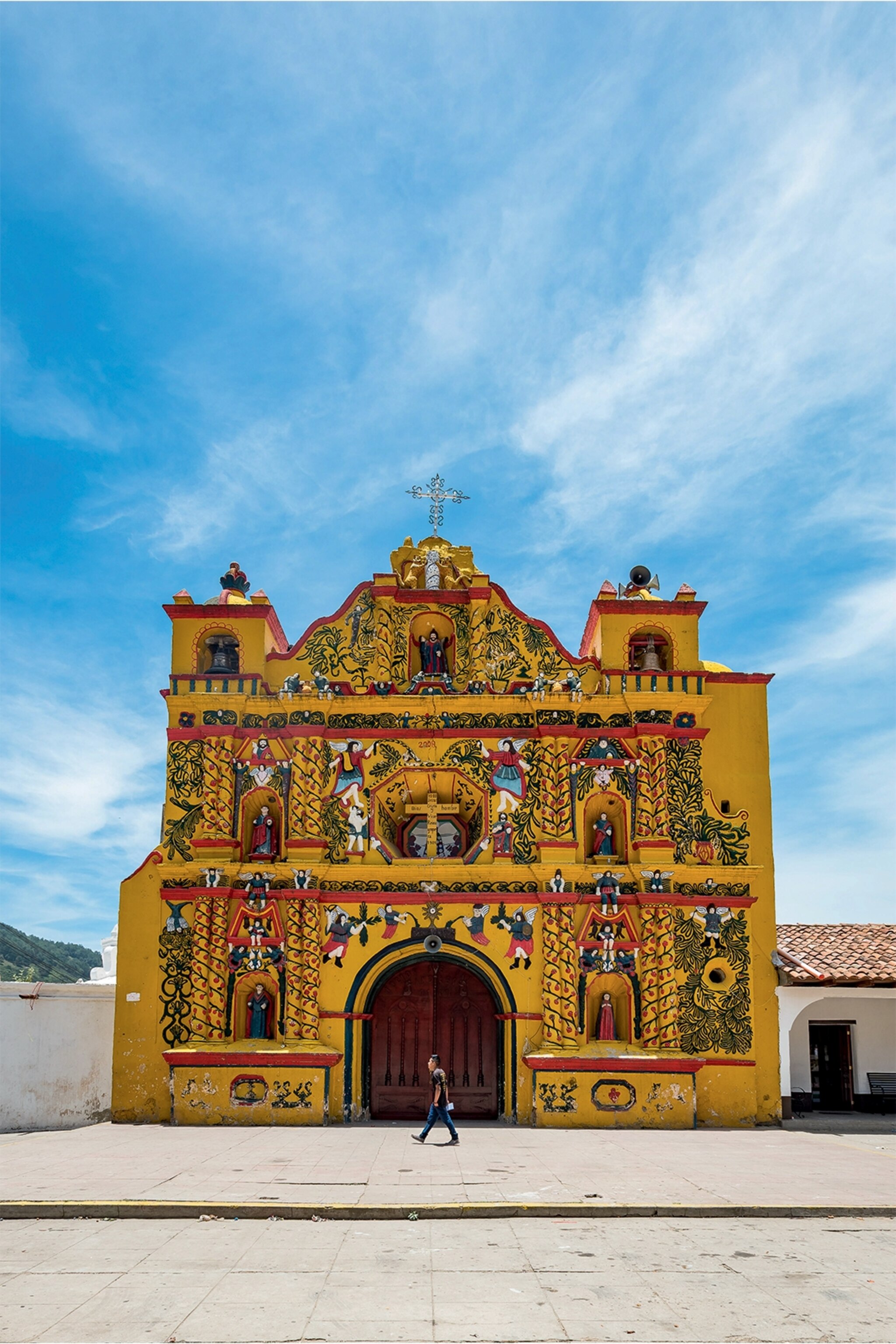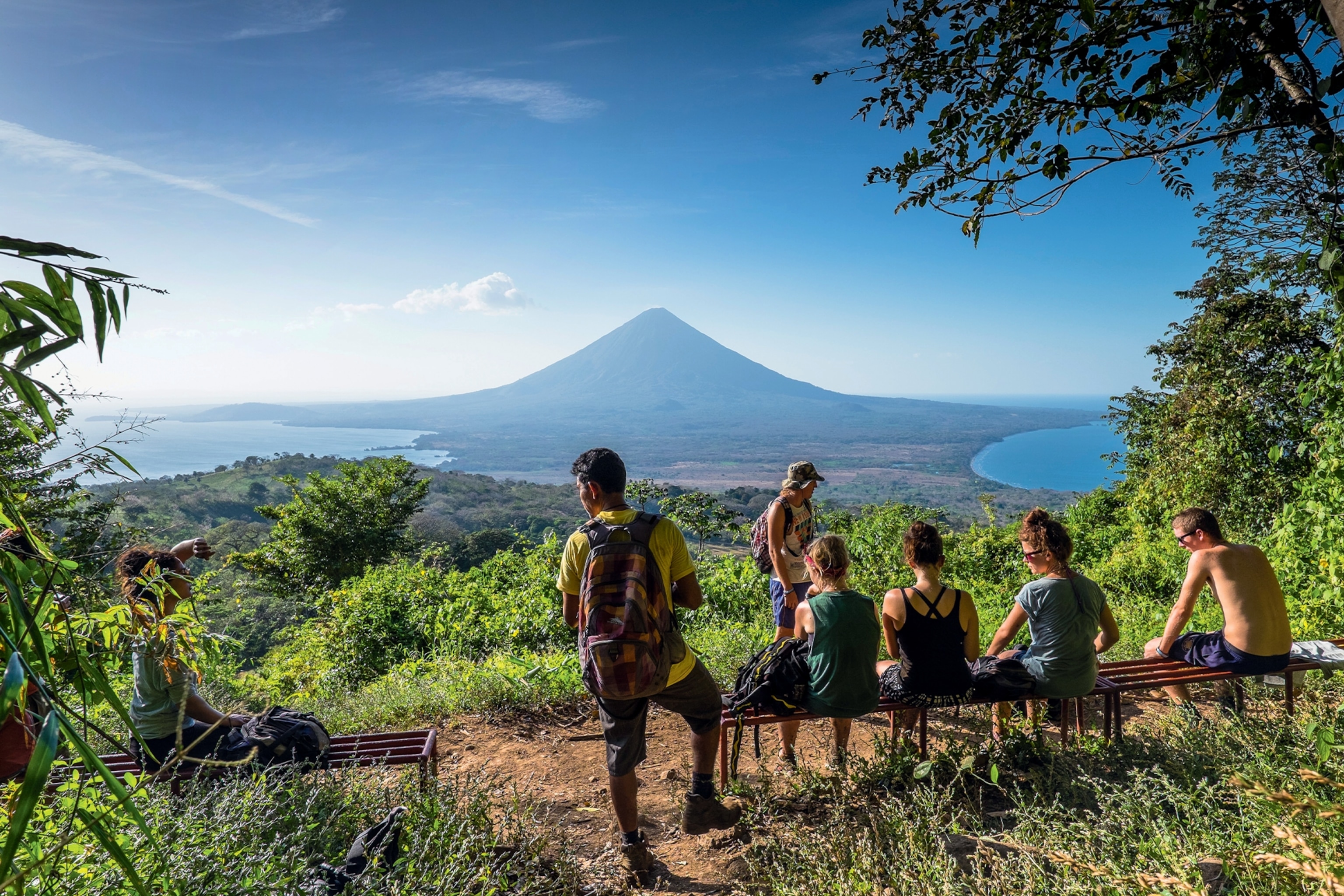Central America stretches precariously thin. Looking at it on a map, the isthmus linking Mexico to Colombia tapers progressively as it reaches southward. At its end, it covers around 30 miles in width — a strip of land so narrow, it seemingly leaves South America hanging on for dear life.
But this compact region is rich in natural treasures — so much so that it attracted the eye of the Spaniards, who arrived in the 16th century in search of gold and silver. The region eventually split into the seven countries known as Central America today: Belize, Guatemala, El Salvador, Honduras, Nicaragua, Costa Rica and Panama. The Spaniards’ legacy is evident from the language to the architecture, with striking cities like Antigua Guatemala — a collection of one-storey homes in shades of coffee and pistachio, and neoclassical and baroque churches.
The conquistadors were hardly the first to set foot here. In the pre-Columbian era, some 80 Indigenous communities inhabited the region alongside the Maya, a civilisation that flourished between 2,000 BCE and AD 1600 from modern-day southern Mexico to Honduras. At their height, the region’s city-states were populated by millions and had ceremonial centres, colossal pyramids and astronomy complexes. Their warrior kings, dressed in jade and feathers, planned battles by reading the stars. They carved their deeds in stone, sculpting elaborate glyphs.
Tikal is famous for its pyramid tombs poking high above the jungle canopy.
Photograph by Macrophotos, Getty Images
Today, travellers can visit the ruins of these ancient civilisations amid Central America’s jungle, most famously those of Chichén Itzá, in the Yucatán, and Tikal in Guatemala. Those descended from the Maya, living predominantly in the Yucatán, Guatemala and Belize, preserve ancient crafts, cuisine and a deeply rooted spirituality. This heritage is on display in destinations like Belize’s Toledo District, with as many as 30 Maya villages, and Guatemala’s Lake Atitlán, sacred to the Maya who still live on its shores.
Earthquakes and some 70 volcanoes have shaped this region in other ways, shattering cities and creating fertile lands for growing coffee, tobacco and fruit. There are beaches to suit every taste, too — some wild with surf, others soft-sand hideaways with clear waters. Inland, tropical jungle, rivers and mountains harbour between 5-12% of the world’s biodiversity; Corcovado National Park in Costa Rica’s Osa Peninsula is a particular highlight. And, underpinning the Yucatán Peninsula is a limestone platform riddled with water-filled sinkholes (known as cenotes) and caves ripe for exploring.
What it all means is that, in the space of just one week on the ground, adventurers can explore a ruin, visit a colonial-era city, browse an indigenous crafts market, climb a volcano, take a coffee plantation tour, ride a wave, spot wildlife from monkeys to jaguars and savour local cuisine. Central America’s compact regions can really deliver like that. Here are two itineraries that encapsulate much of the destination’s charms.
Itinerary 1: Mexico, Belize & Guatemala
Start point: Cancún
End point: Lake Atitlán
Distance travelled: 1,017 miles
Average length: Three weeks
Each year, millions of people visit Cancún, the hub city of the Yucatán Peninsula on Mexico’s Caribbean coast. Not everyone ventures far from its beaches; this itinerary explores some of the highlights on offer to those who do.
While not technically part of Central America, the Yucatán is an excellent practical and cultural gateway to the region, much of which can be seen by car. From Cancún, a highway cuts west to Chichén Itzá, one of the most recognisable pre-Columbian landmarks. For a taste of the country’s natural wonders, travel south, past hippy-chic Tulum, to Sian Ka’an, a protected slice of coast.


The baroque, brightly painted Iglesia del Calvario is just one of the highlights of San Andrés Xecul, Guatemala.
Photograph by Fabrizio Cortesi, Alamy Stock Photo
Cross into Belize via the border at Chetumal. Consider a pit stop in Belize City, on the eastern seafront, then continue inland to the town of San Ignacio, an adventure hotspot. Leave the car behind and take a taxi to the nearby border with Guatemala, where travel by public transport is recommended.
A must-see here is Tikal National Park, another Maya site. From nearby Flores, a flight reaches Antigua in the west of the country. It’s enveloped by volcanoes, with coffee, macadamia and avocado growing on their fertile lanks. End the trip at Lake Atitlán, home to Maya villages of deep-rooted traditions.
1. Chichén Itzá
Some two hours from Cancún, the ruins of this ancient Maya city are dominated by the El Castillo pyramid. You can explore alone, but the site’s tour guides, who’ll meet you at the entrance, will bring its history to life; the temple, for example, is rooted in the Maya cosmological world, with 365 steps reflecting their solar calendar. Sleep at Hacienda Chichen nearby.
2. Sian Ka’an Biosphere Reserve
In the Yucatec Mayan language, Sian Ka’an means ‘Gate of Heaven’. It’s a fitting name for this UNESCO site on the Caribbean coast, about two hours from Chichén Itzá. The lagoon shelters dolphins, manatee and turtles; explore by boat with Visit Sian Ka’an, then stay overnight at Casa Chablé for dark skies and bioluminescence.
3. Actun Tunichil Muknal (ATM)
Point to point, it’s an eight-hour drive from Sian Ka’an to San Ignacio. From here, book a tour of this cave with Caves Branch. You’ll walk, swim and crawl through passageways strewn with skeletons of Maya sacrificial victims, including the ‘crystal maiden’, caked in calcite. Under torchlight, she shimmers as if cloaked in jewels.
4. Tikal National Park
Three hours west of ATM, Tikal is famous for its pyramid tombs poking high above the jungle canopy. From their stone tops, you can spy other pyramid peaks, plus toucans and spider monkeys. Stay at Francis Ford Coppola Hideaway on nearby Lake Petén Itzá to explore the ruins before the crowds arrive with operators like Viavenuture.
5. Antigua Guatemala
While you can continue the journey on land, the one-hour flight from Flores to Antigua will leave you with more time to explore. The Spaniards ruled Central America from the city until it was hit by an earthquake in 1773; 250 years later, it’s risen from its ruins. Highlights include the National Museum of Guatemalan Art, home to everything from jade grave goods to contemporary art.
6. Lake Atitlán
From Antigua, a highway spirals down to Lake Atitlán, a three-hour drive away. It was formed when a volcano blew its top 85,000 years ago; later, around its rim, three young volcanoes were born. It’s a deeply spiritual place for today’s Maya. Seek their crafts in villages, or kayak the lake, with rentals around the shore. Anzan Atitlán has just four rooms, each with floor-to-ceiling windows.
How to do itJourney Latin America’s 19-day bespoke itinerary to Mexico, Belize and Guatemala, featuring Chichén Itzá, San Ignacio, Tikal, Antigua and Lake Atitlán, starts from £4,146 per person, including accommodation, some meals, tours and transport, but not international flights. Itinerary 2: Panama, Costa Rica & Nicaragua
Start point: Panama City
End point: Granada
Distance travelled: 925 miles
Average length: Three weeks
Explore the best of this trio of countries at the southern end of Central America’s land bridge. Start from Panama City, where high-rises hide a revived 17th-century old town and growing food scene. Just west is the iconic canal built to link the Pacific and Caribbean. After exploring the surrounding rainforest, fly west from Panama City to Colón, in the Bocas del Toro Archipelago, to snorkel in waters frequented by dolphins.
A new flight links Bocas del Toro to Costa Rica’s capital, San José. From there, fly to Puerto Jiménez to enter the remote Osa Peninsula, a highlight for adventurers and wildlife-watchers. Return to San José and catch a four-hour bus to Arenal, arguably the country’s best-known volcano.
A six-hour, cross-border bus from Arenal reaches coastal San Juan del Sur in Nicaragua, from where there are one-hour buses or taxis north to San Jorge, on the banks of Lake Nicaragua. Take a ferry to Ometepe Island, then return to the shores for a two-hour shuttle to Granada. It’s a good base from which to visit Apoyo Lagoon Natural Reserve, Mombacho Volcano Nature Reserve and Masaya Volcano.


In southwest Nicaragua’s vast Lake Nicaragua, Maderas Volcano on Ometepe Island looks across to the active Concepción Volcano.
Photograph by Hemis, Awl Images
1. Panama Canal Zone
By bus or taxi, it’s less than a 20-minute drive from Panama City to this century-old, 49-mile waterway. Tour the Miraflores Visitor Center to learn about the canal’s history, then journey into the rainforest around it. Ancon Expeditions runs tours of Gatún Lake, where you can spot monkeys and sloths, or Pipeline Road in Soberanía National Park, ideal for seeing many of Panama’s 1,000 species of birds. Stay at Canopy Tower ecolodge, a converted US radar station.
2. Bocas del Toro
The aerial view of this archipelago in Panama’s Caribbean corner makes landing here a joy. Base yourself in the overwater villas of Nayara hotel, on the main island of Colón, from where it’s easy to take water taxis and arrange tours. Options include chocolate-making with Cacao Blessings, which works with Indigenous women, or outings with Bocas Islands Adventours to spot poison-arrow frogs.
3. Corcovado National Park
Considered one of the world’s most biodiverse regions and celebrating its 50th anniversary in 2025, Corcovado National Park’s lush rainforest shelters scarlet macaws, the endangered Baird’s tapir, jaguars and much, much more. To get the most out of the wildlife-spotting opportunities here — inside the forest, down the Sierpe River as well as on the beaches and Pacific Ocean — take a multi-day, small-group trekking tour with sustainable travel-focused Osa Wild, sleeping inside a ranger station.
4. Arenal Volcano
Picturesque Arenal last spouted lava in 2010. Today, its lower slopes — a national park — are ringed with walking trails. An easy route, El Ceibo, leads through a forest perfumed by vanilla orchids before emerging onto the jagged, solidified lava plain, the fallout from a 1968 eruption. Arenal’s geothermal bedrock heats several hot springs; choose Ecotermales to soak in 40C waters and stroll along rainforest trails.
5. Ometepe Island
Beguiling Ometepe Island, with its twin volcanoes, is adrift in Lake Nicaragua — and feels quite like a place apart. Spend three days here, hiking one of the volcanoes, kayaking the Istián River between the peaks and tasting organic chocolate, coffee and goat’s cheese on tours. Stay at Selvista, an organic, tropical fruit farm that welcomes guests in individual cabins.
6. Colonial Granada
Granada is stuffed full of colourful 16th- to 18th-century Hispanic, neoclassical and baroque buildings. Find pre-Columbian artefacts at the San Francisco Convent, including a collection of monumental statues carved millennia ago, then take in views of the city from the bell tower of Iglesia de la Merced, a 10-minute walk away. Dine on the likes of tiradito (a dish of raw fish) with citrusy leche de tigre marinade at farm-to-table NM Culinary.
How to do itExplore Worldwide has a 25-day Central American Explorer small-group tour, featuring Guatemala, El Salvador, Nicaragua, Costa Rica and Panama, from £3,949 per person, including B&B accommodation, transport and excursions, but not international flights. Published in the December 2024 issue of National Geographic Traveller (UK).
To subscribe to National Geographic Traveller (UK) magazine click here. (Available in select countries only).
Source link : http://www.bing.com/news/apiclick.aspx?ref=FexRss&aid=&tid=67483378ec8c44679b8bcedd45852697&url=https%3A%2F%2Fwww.nationalgeographic.com%2Ftravel%2Farticle%2Fplan-the-ultimate-central-american-adventure&c=522832843767843810&mkt=en-us
Author :
Publish date : 2024-11-27 20:06:00
Copyright for syndicated content belongs to the linked Source.







